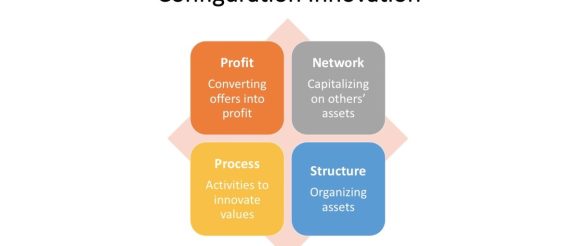What is the configuration innovation, and how do you structure it?

Structuring an innovation business involves configuration that includes the profit model, network, structure, and process. Profit modelling aims at optimizing profitability, the network at capitalizing on external resources, the structure at organizing resources, and the process of achieving operational excellence. In this article, I will highlight the concept of configuration innovation and how to structure it.
What is the configuration innovation?
In Keeley’s book ‘Ten types of innovation’, the author coined the term ‘configuration innovation’, which means how a business is structured to perform innovation and includes profit model, network, structure and process (Keeley, 2013)1.

- Profit model: explains how a firm converts an offer into profit and cash.
- Network: this is when a firm capitalises on its strengths while harnessing the capabilities and assets of others.
- Structure: focuses on organising company assets (physical, human, capital and intangible) in optimised ways to create values.
- Processing: involves activities and operations that enterprises do to make valuable offers and improve efficiency.
How do you structure configuration innovation?
Here is a brief description of structuring the configuration innovation:
(1) Profit model
The profit model involves improving revenues and controlling expenditures, and profit results, if only revenues exceed expenses in a specific period (e.g., one year). Profitability and cash flows are necessary for businesses to survive and grow. The profit model includes revenue types (i.e., transactional and recurring), revenue models (e.g., selling, renting, subscribing, leasing, or membership), pricing considerations (e.g., cost, profitability, or competition), and cost structures (e.g., product costs, variable and fixed costs, contribution margin, breakeven, and sensitivity analysis.). For example, the profit model of Netflix has been radically transforming the movie rental business, at first, into a DVD-delivery one and then into the streaming industry. Profit model tactics include:
- Ad-supported: This is about providing content free to a group of users while selling advertising to other customers.
- Auction: allow customers to set the prices of goods and services.
- Bundling pricing: sell a bundle of goods or services in a single transaction.
- Cost leadership: keep variable costs at the lowest and sell high volumes at low prices.
- Disaggregated pricing: allows customers to exactly buy what they want.
- Flexible pricing: is when prices are based on specific demand.
- Freemium: offers basic services for free while charging a premium for advanced features.
- Licensing: sell rights to use a service for a specific term.
- Membership: charge fees against a set of benefits.
- Subscription: charging customers upfront to access the products or services over time.
(2) Network
Network innovation reveals how a company deals with the stakeholders (e.g., supply chains), and how it approaches the strategies behind the partnerships. You can look at your supply chains and think about opportunities for improvement. Network innovation is open innovation where you can use internal and external sources of information to speed up internal innovation and extend the market for the external use of innovation. Network innovation tactics include:
- Alliances: share risks and revenues to jointly improve individual competitive advantages.
- Collaboration: partner with others for mutual benefits.
- Complementary partnership: partners with non-competitors ( complimentary product suppliers) for mutual benefits.
- Competition: partner with competitors.
- Franchising: license business principles to paying partners.
- Merger/acquisition: combine two different entities to gain access to capabilities and assets.
- Open innovation: get access to patents from other companies to leverage, extend and build on expertise.
- Supply chain integration: is when you partner with the supply chains.
(3) Structure
Structuring innovation aims at searching for the optimal setup of organisation in the company to perform efficiently. Structuring involves arranging human resources, physical assets and non-physical assets to, for instance, increase productivity and efficiency, reduce costs, improve output quality, shorten lead time to the market and reduce waste. For example, investing in an advanced enterprise technology system like ERP to digitally manage business activities. The structure innovation tactics include:
- Asset standardisation: reduce operating costs and increase modularity.
- Competency centre: cluster resources, practices and expertise into centres that support functions across the organisation to increase efficiency.
- Human development: provide training to employees.
- Decentralised management: devolve decision-making governance closer to the people or business interfaces.
- Incentive system: offer incentive schemes to staff.
- IT integration: integrate technology resources and applications.
- Knowledge management: share relevant information internally to reduce redundancy and improve productivity.
- Organisational design: design a structure that serves decentralisation, efficiency, core qualities and business processes.
- Outsourcing: when, for instance, assigning external vendors to maintain a system.
(4) Process
Process capitalises on corporate capabilities, efficiency, agile, lean production, process standardisation and procedures, patent, and proprietary. The process innovations can be judged by skills development, capabilities improvement, cost reduction, patent invention, and technology development. Process innovation tactics include:
- Crowdsourcing: Outsourcing ideas from multi-sources.
- Intellectual property: use a proprietary process to make and commercialise ideas in ways that others cannot copy.
- Lean production: make values that customers want, reduce waste and cost of production, and continual improvement.
- Logistic system: manage the flow of goods, information and other resources between the point of origin and the point of use.
- On-demand production: produce items after an order is received.
- Predictive analysis: model past performance data and predict future outcomes.
- Process automation: apply tools and infrastructure to manage routine activities.
- Process efficiency: create or produce more with fewer resources.
- Process standardisation: using common-practising products, procedures, and policies to reduce complexity, costs, and errors.
- This post is sourced from my new book- Your Guide To Reach Innovation.
Final note: the book- Your Guide To Reach Innovation, is an actionable guide to innovation from beginning to end. Enjoy reading the book, and I look forward to your reviews.
Author: Munther Al Dawood
maldawood@growenterprise.co.uk
References:
- Keeley, L. 2013. Ten types of innovation, Willey, USA.
